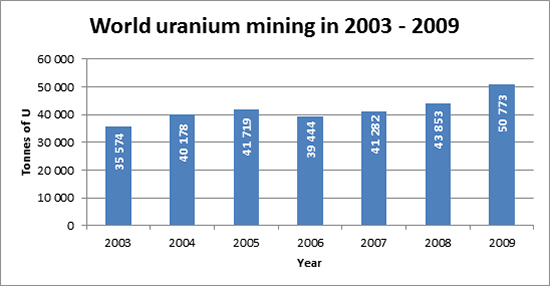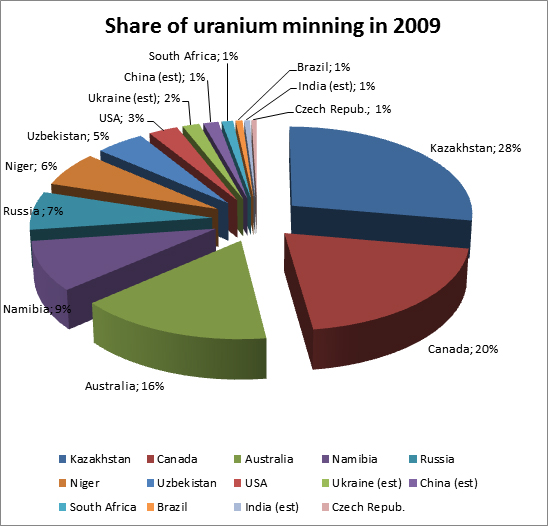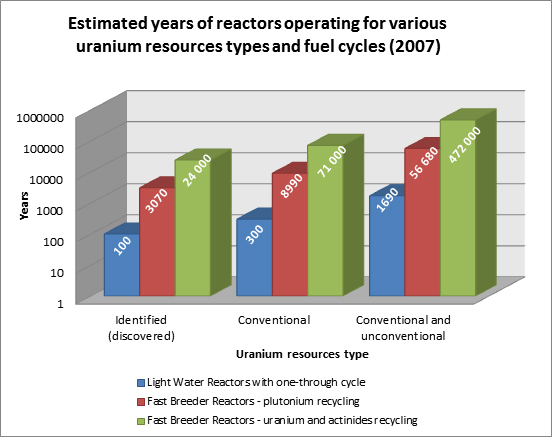
THE ELECTRICITY SUPPLY SYSTEM ASPECT
Problems concerning all sector performance
Fuel cycle : Uranium resources
Figure 29 shows how world uranium mining has been changing since 2003.

Source: "World uranium mining", WNA - World Nuclear Association, May 2010, http://www.world-nuclear.org/info/inf23.html [87]
After stagnation between 2003 and 2008, in 2009 significant increase occurred. Relating to the world economy and its development, further electricity demand increase is predicted. Due to this, and as a consequence of nuclear power plant constructing, consumption of uranium will have growing trend. This assumption is proven in Chapter 2.2. In the Figure 30, is shown country share in uranium mining in 2009.

Source: "World uranium mining", WNA - World Nuclear Association, May 2010, http://www.world-nuclear.org/info/inf23.html [87]
Three, the most important uranium producers are Kazakhstan, Canada and Australia. Location of mines is very neutral. Those country are politically balanced and predictable. Therefore uranium prices do not depend on geopolitical conditions. Uranium is highly widespread in the Earth's crust. It occurs in large quantities also in the oceans. However its concentration around us is relatively small. Uranium does not form a dense layers with exception of ores deposited 450 m under Cigar Lake in Canada. Those ore contains 15% of pure uranium. In normal, common ores quantity of pure uranium is significantly lower. Additionally, as it had been mentioned, even in pure uranium there is only 0,6% of fissile isotope. Nevertheless natural resources of uranium are estimated always in relation to the cost of extraction. It is happening because of the cost of uranium determines which resources are profitable to extract. The cost factor has caused that available uranium resources are divided in several groups with price's categories. The first group includes known commercial reserves of uranium, that can be extract with present technology at defined price. Its estimations are the most reliable. For the moment, according to [83], [88] identified conventional uranium resources with cost factor less than $130/kg of uranium (kgU) are estimated at level of 5,7 MtU (million tonnes of uranium). These estimations are continuously increasing. In 2007 there was a 5,5 MtU estimation. Extending possible range of cost factor to $260/kgU brings additional 0,7 MtU. Uranium price, according to [89],[90] (to date 18.03.2011) is $132/kgU (as 18.03.2011), but in 2010 it has been fluctuating between $90/kgU and $160/kgU. Therefore total identified conventional uranium resources can be assumed at 6,4 MtU. Second group of undiscovered conventional resources means uranium expected to occur in area of existing, discovered ores or near them and also includes speculative resources with unspecified extraction cost. At a cost of $80/kgU-$130/kgU, they are estimated of 6,3 MtU, additional 0,2 MtU at a cost of $130/kgU-$260/kgU and further 3,6 MtU at unspecified cost. In optimistic scenario it equals 10,1 MtU. All conventional resources brings 16 Mt of uranium. Current global electricity generation by nuclear power plant is around 2600 TWh. [34]. Uranium consumption for fuel production to ensure electricity generation of 1 TWh, at a conservative estimate, is 25 000 tU (once through fuel cycle). Hence identified conventional uranium resources will be sufficient for light water reactors to operate for 98 years (6,4 MtU with extraction cost up to $260/kgU). This period can be extended to 246 years if undiscovered conventional resources are confirmed ( 16 MtU with no concerns about the extraction cost ). Possible operation period is calculated, based on current electricity generation supplied by nuclear energy. Relating to [33] global number of reactors will increase and power capacities installed will reach 553 GWe in 2025. As a consequence uranium demand will be 90 000 tU/year (today it is 65 000 tU/year). Continuous growth can lead to power capacities installed increase, up to 1300 GWe in nuclear power plants in 2050. With assumption of natural uranium consumption of 150 t/GWe per year, all estimated resources will reserved for operating reactors. Nuclear power plant construction is not possible when there are no guaranteed uranium resources for all its operating time. Thus, according to The European Union, further reactors in fission technology can not be built since 2050. This is the reason why development in area of fast reactors and fusion technology is very important. Figure no. 31 shows how reactors estimated years of operation depend on fuel cycles and type of uranium resources.

Source: "Climate change and nuclear power 2009", IAEA - International Atomic Energy Agency, Vienna, 2009, [91]
Last group of unconventional resources includes those with very low uranium concentration (measured with ppb - part per billion) and those in which uranium is obtained only as by-product. It is between 7 and 22 MtU obtained by phosphate production. Seawater has a large potential of 4500 MtU. Unfortunately concentration of uranium in seawater is only 3,3 ppb, what means 0,0033 ppm. Hence, 330 000 tons of water is require to obtain 1 kgU. Japanese scientists, who are involved into researches over uranium production from seawater, indicate that there is possible to construct reprocessing plant able to produce 1200 tU per year, at cost of $300/kgU. It is expensive today, but in relation to uranium price fluctuation in 2010, when it has reached $160/kgU, price of $300/kgU does not seem to be unaffordable in long term. How consideration of unconventional uranium resources affects estimated reactors operation time, is shown in Figure no. 31. It is important to admit that global uranium demand of 65 000 - 68 000 tons of uranium is not completely covered by uranium mining. As shown in Figure no. 29, in 2009 production of uranium was at level of 50 000 tU. Missing share is ensured by several sources like [84] :
[7],[33],[81],[83],[84],[85],[86]
-
Nuclear power industry|
Technology|
The electricity supply system aspect|
Economics|
Environment|
Public aspect|
Future|
Legislation|
References|

